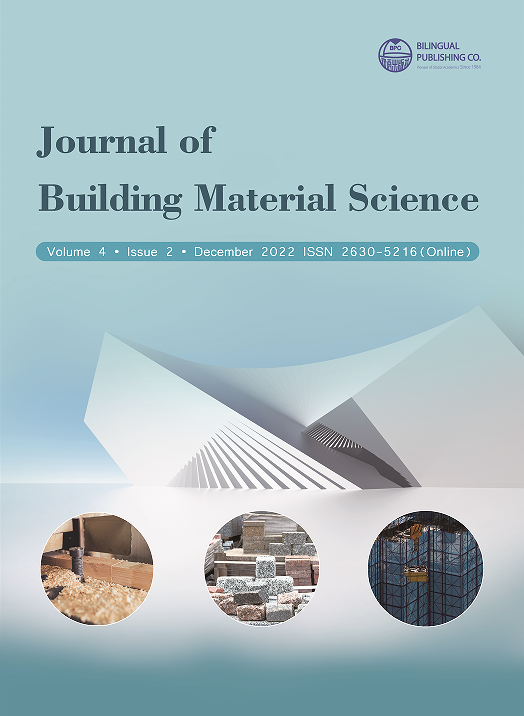
Impact of Polymer Coating on the Flexural Strength and Deflection Characteristics of Fiber-Reinforced Concrete Beams
DOI:
https://doi.org/10.30564/jbms.v4i2.5304Abstract
Liquid polymers (LP) have become an important structural material used in the construction industry in the last decade. This paper investigates the viability of using commercially available LPs as a coating material to improve the flexural strength of fiber-modified concrete beams. The scope included preparing rectangular prism concrete beams with a concrete mixture including fly ash and fiber and coating them with four different liquid polymers at a uniform thickness following the curing process while one set of samples was maintained under the same conditions as a control group without coating. In addition, cylindrical samples were prepared to determine the compressive strength of the concrete mixture. Following the curing process in an unconfined open-air laboratory environment for another 28 days, concrete samples were tested to determine the flexural strength and deflection characteristics under center point loading equipment. The results revealed that all four coating types enhanced both the flexural strength and the average maximum deflection of the beams compared to the control group. While the enhancement in the flexural strength changed approximately between 5% and 36% depending on the coating type, the improvements in average maximum deflections varied between 3.7% and 28.4%.
Keywords:
Concrete coating; Liquid polymers; Flexural strength; Deflection; Magnetic inductionReferences
[1] Anonymous, 2021. Concrete needs to lose its colossal carbon footprint. The International Journal of Science. 597, 593-594.
[2] EMC Cement, 2022. The Scale of Concrete [Internet] [Accessed 2022 Nov 24]. Available from: https://lowcarboncement.com/the-scale-of-concrete
[3] Aguiar, J.B., Camoes, A., Moreira, P.M., 2008. Coatings for concrete protection against aggressive environments. Journal of Advanced Concrete Technology. 6(1), 243-250.
[4] Rodrigues, M.P., Costa, M.R.N., Mendes, A.M., et al., 2000. Effectiveness of surface coatings to protect reinforced concrete in marine environments. Materials and Structures. 33, 618-626.
[5] Kropp, J., Hilsdorf, H. (editors), 1995. Performance criteria for concrete durability : State of the art report prepared by RILEM Technical Committee TC 116-PCD. Performance of Concrete as a Criterion of its Durability. E & FN Spon: London.
[6] Zhao, Z., Qu, X., Li, J., 2020. Application of polymer modified cementitious coatings (PCCs) for impermeability enhancement of concrete. Construction and Building Materials. 249, 118769.
[7] Ahmed, A., Guo, S., Zhang. Z., et al., 2020. A review on durability of fiber reinforced polymer (FRP) bars reinforced seawater sea sand concrete. Construction and Building Materials. 256, 119484.
[8] Li, Z., 2011. Advanced concrete technology. John Willey and Sons, Hoboken, NJ: USA.
[9] Deshrousses, R., Soliman, A. (editors), 2018. The uses of polymers in concrete: Potentials and difficulties. Building Tomorrow’s Society; 2018 Jun 13-16; Fredericton, Canada. Canada: CSCE SCGC.
[10] ACI committee 548, polymers in concrete, 2009. Report on Polymer Modified Concrete. American Concrete Committee Reports. ACI 548.3R-09. 1-40.
[11] Gambhir, M.L., 2008. Concrete technology. McGraw Hill Education: Patiala, India.
[12] Elsayed, M., Elsokkary, T., Shohide, M., et al., 2019.Surface protection of concrete by new protective coating. Construction and Building Materials. 220, 245-252.
[13] Chi, J., Zhang, G., Xie, Q., et al., 2020. High performance epoxy coating with cross-linkable solvent via Diels-Alder reaction for anti-corrosion of concrete.Progress in Organic Coatings. 139, 105473.
[14] Almusallam, A., Khan, F.M., Maslehuddin, M., 2002. Performance of concrete coatings under varying exposure conditions. Materials and Structures. 35, 487-494.
[15] Urgessa, G.S., Esfandiari, M., 2018. Review of polymer coatings used for blast strengthening of reinforced concrete and masonry structures. Taha, M. (editor) International Congress on Polymers in Concrete (ICPIC 2018). Springer: Berlin/Heidelberg, Germany. DOI: https://doi.org/10.1007/978-3-319-78175-4_91
[16] Irshidat, M., Al-Ostaz, A., Cheng, H.D., et al., 2011. Nanoparticle reinforced polymer for blast protection of unreinforced masonry wall: Laboratory blast load simulation and design models. Journal of Structural Engineering. 137(10), 1193-1204.
[17] Liu, L., Zhao, P., Liang, C., et al., 2022. Assessment and mechanism of inorganic hydrophobic flake incorporated into a polymer-modified cement-based coating. Journal of Building Engineering. 60, 105185.
[18] Tran, N., Nguyen, T., Ngo, T., 2022. The role of organic polymer modifiers in cementitious systems towards durable and resilient infrastructures: A systematic review. Construction and Building Materials.360, 129562.
[19] Cho, S., White, S.R., Braun, P.U., 2009. Self-healing polymer coatings. Advanced Materials. 21(6), 645-649.DOI: https://doi.org/10.1002/adma.200802008
[20] Cho, B.H., Nam, B.H., Seo, S., et al., 2019. Waterproofing performance of waterstop with adhesive bonding used at joints of underground concrete structures. Construction and Building Materials. 221, 491-500.
Downloads
How to Cite
Issue
Article Type
License
Copyright © 2023 Kasim Korkmaz

This is an open access article under the Creative Commons Attribution-NonCommercial 4.0 International (CC BY-NC 4.0) License.







 Salih Kocak
Salih Kocak





